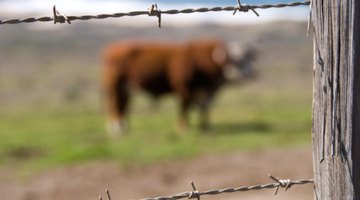How to Stretch Barbed Wire Fencing
Barbed wire fences are made by stringing rows of barbed wire between fence posts. The rows are hung individually, and to create an effective fence, the wire must be stretched tight before it is secured to a post.

Things You Will Need
- Barbed wire
- Come-along wire tool
- Lumber, concrete and wire for creating fence assemblies and fence posts
Tip
Individual strands of barbed wire that have come loose on an existing fence can be restretched in the same manner; attach a come-along to the strand and stretch it to the next brace assembly or corner, and then reattach it to the line posts once it is secured to the assembly.
Warning
Always wear heavy gloves when working with barbed wire to prevent cuts and puncture wounds.
Loose barbed wire not only increases the chance of the fence failing but also presents a hazard to any livestock that the fence was erected to enclose. Because barbed wire fences are erected one strand of wire at a time, stretching the fence is done strand by strand as each is hung.
-
Create a corner brace assembly if you don't have one, driving the corner fence post in a hole 20 inches across and 3-1/2 feet into the ground. Dig the holes for the two bracing posts 8 feet away, making them 20 inches across and 2 feet deep. Use concrete to reinforce the posts, and then connect them using horizontal beams from the tops of the bracing posts to the top of the corner post. Run a wire from the top of each bracing post to the bottom of the corner post to provide additional support, pulling it tight before securing it. Connect this wire to the beams using an additional length of wire.
-
Install additional posts (known as line posts) 15 to 20 feet apart in the direction you plan on installing the fence, using a cord or chalk line to ensure that your posts are in a straight line. Create additional brace assemblies every 650 feet in the same manner that you made your corner brace, keeping the brace assembly straight instead of using it to create a corner. Continue driving line posts and constructing brace assemblies as needed until you reach the next corner of your fence; build another corner brace assembly, and then return to your starting corner.
-
Attach your first strand of barbed wire to the corner assembly using a wire clip or galvanized steel staple, positioning it toward the top of your corner post. If you are using your fence to contain livestock, then the barbed wire should be on the side where the livestock will be kept; otherwise, place it along the outside of the fence.
-
Pull the barbed wire to the bracing post, and then attach a come-along to the wire and pull it tighter. The come-along is a specialized wire clamp designed for use with wire fencing, wrapping around the wire and holding it in place while the come-along itself is attached to a chain or hook and pulled. When the barbed wire is fully taut against the bracing post, secure it with a wire clip or staple.
-
Run the strand of barbed wire to the next brace assembly or corner assembly, whichever is closest. Attach the come-along again, pulling the wire taut and securing the barbed wire to the first bracing post. Stretch the wire again and connect it to the middle post as well.
-
Return to the first line post you passed when stretching the barbed wire. Secure the barbed wire to the post, and then move on to the next. Continue working to the bracing assembly you stretched the barbed wire to, attaching the wire to each line post to keep it taut and prevent sagging.
-
Continue stretching the barbed wire from one brace assembly to the next until you have secured the strand from one corner assembly to another. Secure the strand to all of the line posts, and then return to the original corner and begin stringing the next strand down. Repeat these steps until you have completed every strand of barbed wire that will hang on this length of fence.
-
Repeat the process for the remaining lengths of fence, starting with the top strand and working your way down. Any new wire that must be added to the fence should be added to the middle post of a corner assembly or brace assembly, and stretched taut with a come-along before it is secured to the brace post so it doesn't create a weakness in the fence.
References
Writer Bio
Born in West Virginia, Jack Gerard now lives in Kentucky. A writer and editor with more than 10 years of experience, he has written both articles and poetry for publication in magazines and online. A former nationally ranked sport fencer, Gerard also spent several years as a fencing coach and trainer.
Photo Credits
- Jupiterimages/Photos.com/Getty Images
- Jupiterimages/Photos.com/Getty Images
More Articles



